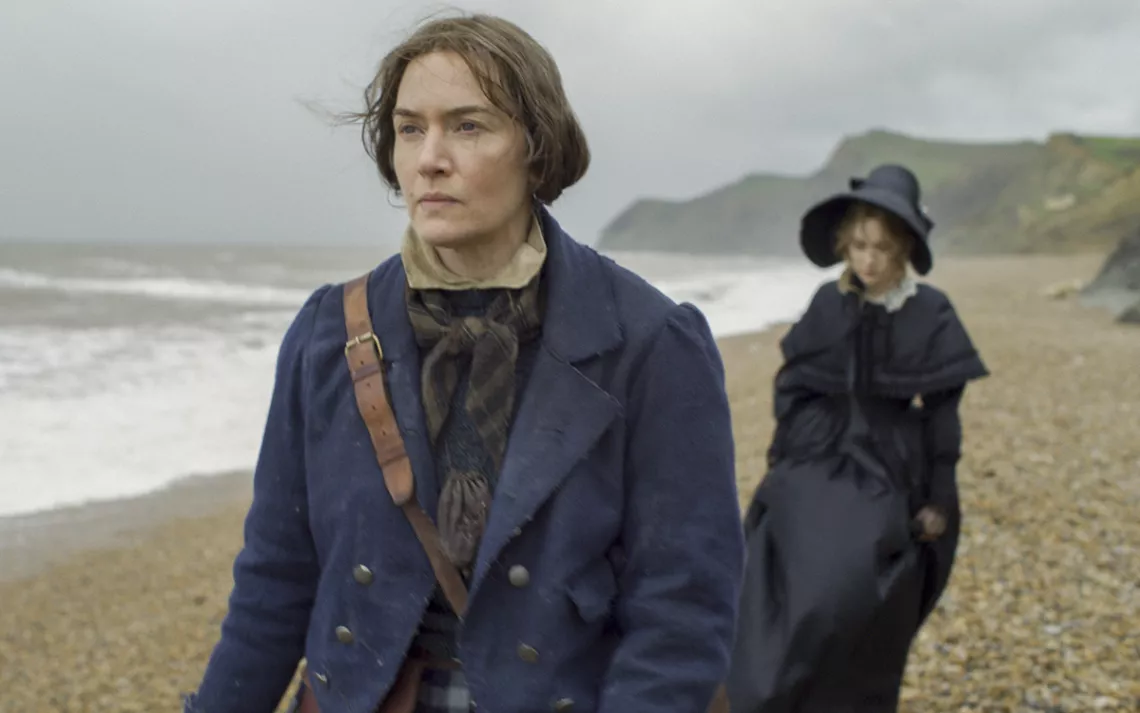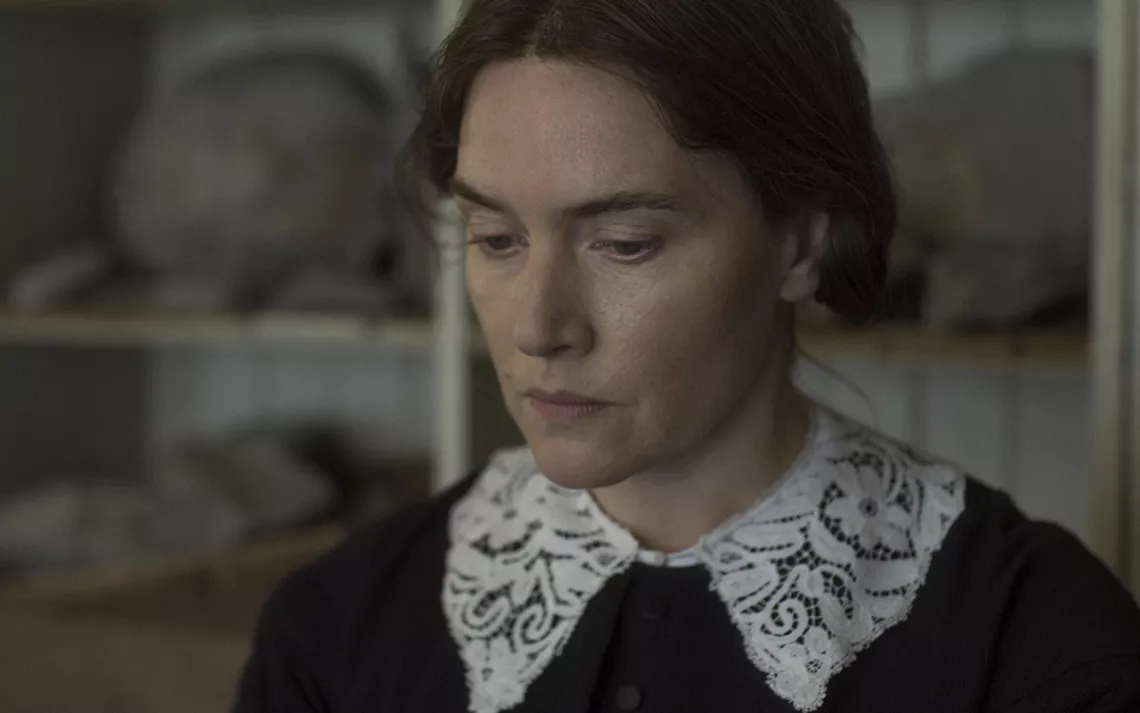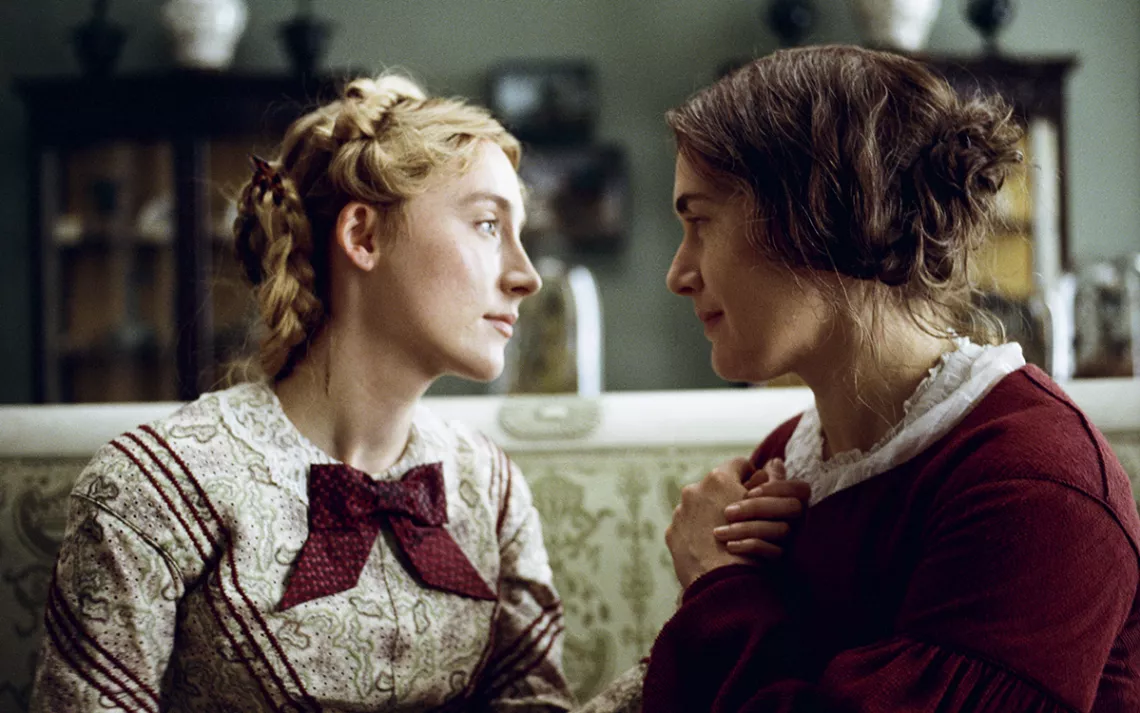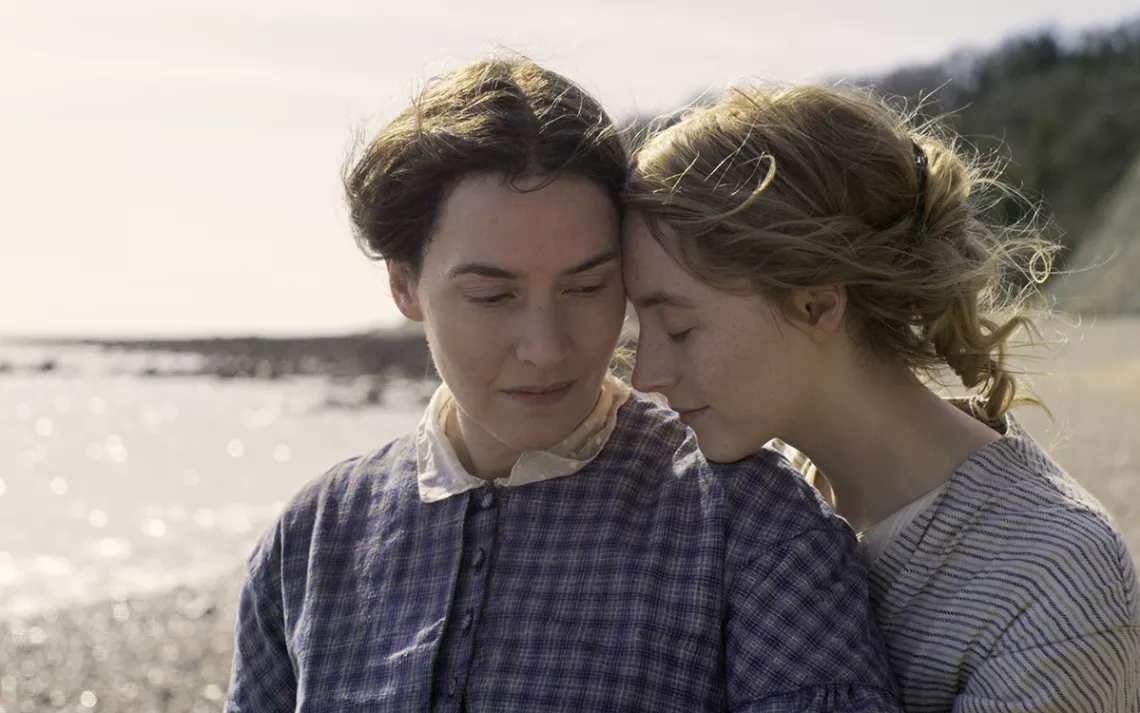6 Scenes That Should Have Been in "Ammonite"
Justice for Mary Anning (and her sea lizards!)

Kate Winselt and Saoirse Ronan go off to do some excavating. | Photo courtesy of NEON
The film Ammonite does not make being a woman who is obsessed with fossils in 1840s England seem at all like a good time. In the opening scene, Kate Winslet, portraying real-life paleontologist Mary Anning, grimly scales rimy cliffs in petticoats with as many layers as a brussel sprout, buffeted by blustery winds. When Winslet tries to pry out an ammonite fossil from the cliff with only her bare hands, the task proves unsurprisingly impossible, and she and the fossil tumble downhill. When she returns home, she undresses in the kitchen and scratches her armpits with a coarse sort of sponge while her ailing Victorian mother coughs bloody phlegm into her kerchief. Winslet seems to barely notice the coughing, I guess because this is just something ailing Victorian mothers do.

Was the real Mary Anning this glum? Discuss. | Photo courtesy of NEON
Directed by the filmmaker Francis Lee, Ammonite imagines a Mary Anning that reviewers have deemed muted at best and dour at worst. Anning, played with unfailing moodiness by Winslet, does not smile until one hour and nine minutes into the movie. To be fair, the real Anning would have had plenty to be grumpy about: a limited dating pool, the recurrent and lifelong theft of her intellectual property by dull and conniving white men. But a male geologist who was a contemporary of Anning’s described her as “shrewd, and satirical in her conversation,” which seems like more than enough proof that the real deal cracked a joke or two.
In the film, though, excitement appears in the form of Charlotte Murchison, played by Saoirse Ronan. Murchison, the young wife of a geologist and a sullen cupcake of a woman, has had enough of this world and wishes only to remain in bed among her many pillows. Fossils do not tempt Charlotte, nor does the mystery meat pasty Anning offers as lunch on a seaside trip. Charlotte’s palate is only whetted by Anning herself, and after exchanging the obligatory glances (furtive) and touches (fleeting), the two begin a fitful, panting affair.
Reviewing Ammonite for Smithsonian, the writer and paleontologist Riley Black aptly pegs it as paleo fan fiction. There is no historical evidence that Anning was a lesbian, just as there is no evidence that she was straight. Anning never married, and there are no records of her having a relationship with or romantic or sexual feelings toward anyone. In fact, as Black points out, Anning could have been asexual.
I am not entirely opposed to queering the history of lesser-known historical figures. Anning’s various biographies failed, in many ways, to do justice to the story of a working-class woman whose significant contributions to science continue to go unrecognized, despite the efforts of paleontological historians like Hugh Torrens, who describes her as “the Greatest Fossilist the World Ever Knew.” At least now more people will know Mary Anning’s name.
Ammonite does include a few clues to Anning’s work. We see her digging what appears to be ink out of a rock and sketching with it. In fact, Anning was the first to discover that belemnites, ancient squid-like cephalopods, had ink sacs that remained even after fossilization, and she did excavate those ink deposits to draw with. In another scene, Roderick, Charlotte’s husband, proudly shows Anning a fossil that she quickly dismisses as an ancient turd. But there is no mention that Anning was the first to discover the bone-filled lumps often called bezoar stones were actually coprolites, or fossilized poop. And while Anning excavated ammonites aplenty, discoveries that kept her shop stocked for collectors, her most significant scientific discoveries were sea lizards.
It’s not clear why Ammonite depicts paleontology as such dreary work, especially for someone who clearly found it interesting enough to devote her life to studying it. Ammonite does Anning a disservice by prioritizing an invented romance over her actual discoveries, which include, among many other things, a legendary ichthyosaur fossil and two nearly complete plesiosaurs.
Lesbians, science enthusiasts, and prehistoric sea lizards deserved so much more—a cinematic language that represented them in all their splendor. So to fill in some of these gaps, here are a list of scenes that should have been in Ammonite, and that you are free to imagine actually were.

Torrid romance is nice, but so are fossils. | Photo courtesy of NEON
A flashback to Mary’s youth, when she digs up a four-foot ichthyosaur skull with her brother Joseph.
Mary—who in this flashback is played by Twilight-era Kristen Stewart—rolls her eyes and puts her hands in her pockets. “Cool, I guess,” she says.
Out fossil hunting, Mary hitches up her toolbelt and rummages through her ample pockets.
“You can store anything in these bad boys,” Mary mutters to herself, emptying the contents of her cargo-like petticoats as proof: cigarettes, a handful of ammonites, a surprisingly intact meat pasty, a ripped-out page of her melancholic poetry, several carabiners chock-full of excavating tools, crumbs from another pasty, an emptied bottle of tincture she got from her ex that she swears she’s going to throw away (she just hasn’t gotten around to it yet, and besides, who knows ... maybe Elizabeth is right and they will get back together one day).
Mary runs into her ex-girlfriend, Elizabeth, while picking up a salve for her new girlfriend, Charlotte.
Elizabeth, standing in a ray of sun surrounded by a peak-cottage-core backdrop of flowers and buzzing bees, smiles beatifically at Mary, who probably ghosted her. “Here, Mary, take a salve, which I am giving unto you for free out of the goodness of my heart, even though you ghosted me,” Elizabeth says. “I forgive everyone, for I am a Pisces.”
Mary takes the salve but presses several coins into Elizabeth’s palm, to her visible annoyance, before walking away.
“I knew I should never have dated a Gemini!” Elizabeth screeches.
After seeing Elizabeth flirt with Charlotte at a party, Mary walks home bleakly in the rain to chip away at an ichthyosaur skull in her excruciatingly dim study.
“You left the party,” Charlotte says, walking into the room.
“I wanted to work,” Mary says.
“Don’t you see, Mary, you’re like an ammonite, something cold and hard as stone. I, Charlotte, am the chisel that’s meant to reveal your true self, emotional layer by emotional layer!” Charlotte says, grasping at the ichthyosaur skull with her pale, monied hands.
“Please don’t touch that—your hands are oily from the dinner pasty,” Mary says. “Charlotte, you are very young and very hot, which you very much know, but I’m working right now, and my work is very important to me. It is how I pay the bills—you can see I am not rich—and I have to provide for my ailing Victorian mother. But this is also the great passion of my life, excavating these fossilized sea monsters and their fossilized shit. The sea lizard ichthyosaurus was named after a fossil I found when I was 12. I found two complete plesiosaur skeletons. I found a pterosaur. I discovered that ancient squid ink could be fossilized. I also—and nobody ever talks about this—found this truly wild fossilized fish, Squaloraja, which looked like a shark and a ray made sweet, sweet love and popped this guy out! Maybe we could make sweet, sweet love, too, if you would just stop interrupting me while I’m working and touching my specimens.” Mary realizes that she is shouting.
“Oh, well, that sounds nice, and I would like that very much!” Charlotte shouts back and lights an additional dozen candles so Mary can actually see the fossil she’s excavating. The two women share a smile. The next morning they make out on the beach.

You can make out on the beach AND make groundbreaking scientific discoveries. | Photo courtesy of NEON
Mary and Charlotte make out on the beach.
Worn out from a cold morning spent poking through dirt, Mary rummages around in her pocket for lunch, a pasty filled with cabbage, potatoes, or some combination of the two. But when Mary reaches for her pasty in her dirty apron, Charlotte reaches too. Mary’s pinky grazes something soft—is it Charlotte, or perhaps the pasty? Mary cannot tell; she has become so familiar with rock that she knows nothing of the difference between flesh and crumb.
Yearning orchestral music crashes in like a wave, cuing a montage: Mary and Charlotte, slow-dancing on the beach. Mary and Charlotte, splashing each other in the waves. Mary smoking a cigarette and passing it back to Charlotte. Charlotte, rubbing the crimped side of the pasty against Mary’s neck, where it comes off in small, warm flakes.
“Every fossil hunt before this one I’ve been asleep,” Mary says, tracing Charlotte’s cheek with the crimped side of the pasty. “But now, Charlotte, I am awake.”
“I feel as if we are the only two ammonites left alive in the prehistoric sea that once swallowed Lyme Regis, the last two to die after the local extinction event that left all these fossils here,” Charlotte says, pressing Mary’s palm into her cheek.
“You remembered,” Mary says and smiles, for she is always smiling now, with Charlotte.
“You said it could have been a toxic algal bloom that killed them,” Charlotte says, falling to the ground with Mary so that their bodies nestle softly in the sand. They are both thinking the same thing: If a nearby cliff were to suddenly collapse and bury them, they might become fossils too.
“My husband has his ammonites,” Charlotte says, lying next to Mary, grasping the pasty. “But you, you are my ammonite.”
A flashback to the late Jurassic, in a scene much like the watercolor Duria Antiquior (A more Ancient Dorset), painted in 1830 by the geologist Henry De la Beche based on fossils found by Mary Anning.
A lone ammonite bobs around in its multichambered shell, pushed around by the many plesiosaurs darting around these crowded waters. Its day is like every other it has known: vaguely in search of food but incapable of moving very fast in any one direction.
But suddenly, out of the corner of its eye, the ammonite spies another ammonite, enticingly mysterious in the way that shelled creatures often are. While the first ammonite’s shell is brown and tightly coiled—relatively butch, as far as ammonites go—the second ammonite is strikingly ornate, its ribbed shell coiling like a pyramid with a curlicue on top like Didymoceras.
The first ammonite approaches the second and gives the other a little nod, as if to say, "Hey, are you picking up what I’m putting down?" A plesiosaur passes between them, spinning the first ammonite around so that it can’t see the other ammonite nod back. Both too nervous to make the first move, the ammonites enter into an intense platonic friendship in which they often stare into each others’ eyes and yearn, yearn, yearn.
 The Magazine of The Sierra Club
The Magazine of The Sierra Club



